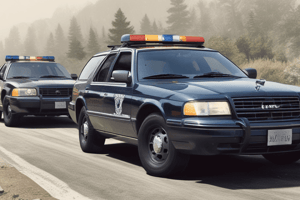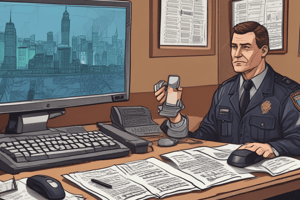Podcast
Questions and Answers
What should non-fire related IOF observations include?
What should non-fire related IOF observations include?
- What was seen, felt and/or heard (correct)
- The height of the building
- The weight of the responders
- The type of fire extinguisher used
When should IOF’s be completed?
When should IOF’s be completed?
- Before going off duty, prior to the end of shift (correct)
- After consulting with the district chief
- After the end of shift
- After reviewing the incident commander's report
What happens to the original IOF forms after they are reviewed and signed by the Platoon Chief?
What happens to the original IOF forms after they are reviewed and signed by the Platoon Chief?
- They are forwarded directly to the RMS section for filing (correct)
- They are destroyed
- They are given to the Incident Commander
- They are stored in the Commander's office
Who is responsible for ensuring that copies of the IOF’s are provided directly to the Investigator?
Who is responsible for ensuring that copies of the IOF’s are provided directly to the Investigator?
What happens to the copies of the IOF’s in the Platoon Chief office and Commander’s office after the RMS section has indicated receipt of same?
What happens to the copies of the IOF’s in the Platoon Chief office and Commander’s office after the RMS section has indicated receipt of same?
What is required in addition to an IOF for incidents that involve a firefighter injury or near miss?
What is required in addition to an IOF for incidents that involve a firefighter injury or near miss?
What key information should be noted and reported?
What key information should be noted and reported?
Where are the received IOF’s scanned and saved?
Where are the received IOF’s scanned and saved?
Flashcards are hidden until you start studying
Study Notes
IOF Observations
- Non-fire related IOF observations should include:
- Descriptions of what was seen, felt, and/or heard
- Specific time frames involved
- General surroundings and environment
- Physical actions of parties involved
- Pertinent verbal statements (or threats) made
- Unique characteristics or identifying features (e.g. tattoos)
Completing IOF Reports
- Officers responsible for completing the report in RMS shall click the "IOF" checkbox on the Basic/Supplemental tab
- IOFs are to be completed before going off duty, prior to the end of shift, unless directed otherwise by the Incident Commander
Distribution and Filing of IOFs
- Original forms are to be picked up by the District Chief and taken to the Platoon Chief's office as soon as reasonably possible
- Reviewed and signed IOFs are to be forwarded directly to the RMS section for filing
- On-Duty Platoon Chiefs ensure that copies of IOFs are provided directly to the Investigator from the Toronto Fire Investigations Unit
- Once received by RMS section, an email reply is sent to the Platoon Chief, Commanders, and TFS Investigations Unit, advising receipt
- Copies in Platoon Chief office and Commander's office are to be confidentially destroyed after receipt
- Hard copies of IOFs are not required to be stored on file
Electronic Filing and Additional Requirements
- RMS scans and saves received IOFs in the Electronic File Saving system (EFS)
- If an IOF is required or requested for incidents involving firefighter injury or near miss, personnel must also complete an injury/near miss observation form
Key Information to Report
- Building security upon arrival
- Unusual fire or smoke conditions
- Whether smoke or fire alarms were sounding on arrival
- Whether smoke alarms were disabled or removed during suppression or overhaul
- Fire size upon arrival and when extinguishing agent was applied
- Any delays in applying extinguishing agent
- Accelerants found in or around the building
- Locations where victims were found prior to rescue
- Suspicious individuals present at the scene
- Positions assigned on the fire scene, including those assigned to fire watch or maintain scene security following the event
- Relevant information or observations for non-fire incidents
Studying That Suits You
Use AI to generate personalized quizzes and flashcards to suit your learning preferences.




